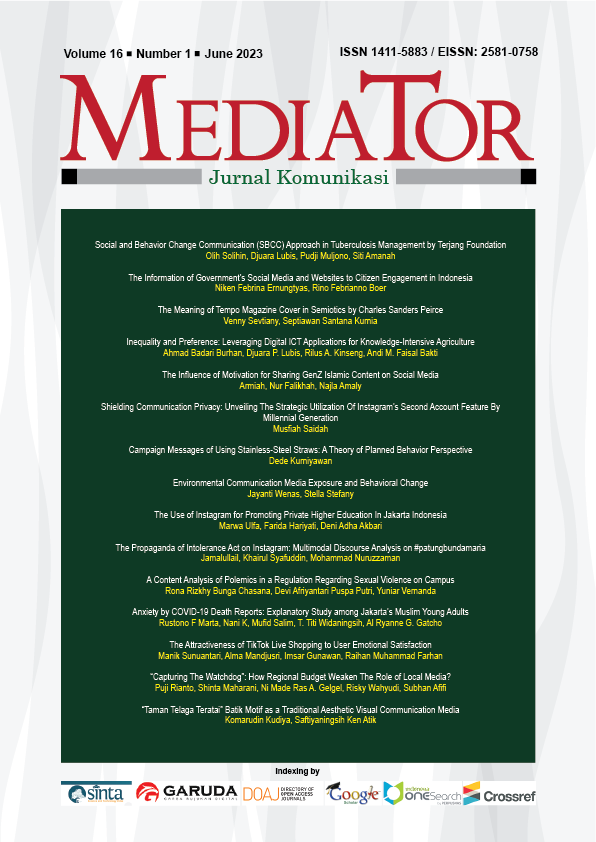The Propaganda of Intolerance Act on Instagram: Multimodal Discourse Analysis on #patungbundamaria
DOI:
https://doi.org/10.29313/mediator.v16i1.2357Keywords:
The Virgin Mary, multimodal, statues, propaganda, discourseAbstract
The case of covering the Virgin Mary statue using a tarpaulin is one of the viral cases related to religious issues. The case involved an Islamic mass organization in Kulon Progo Yogyakarta and the owner of the Sasana Adhi Rasa prayer house, ST Yacobus. Some of the posts about the case use the hashtag #patungbundamaria. Hashtags, which intended originally to promote sculpture products, suddenly used to increase the reach of spreading issues. This is as an effort to carry out propaganda that has the potential to bring up a discourse of intolerance. This study aims to determine the form of multimodal discourse from the case of the closing of the Bunda Maria statue in Kulon Progo, as well as the propaganda formed. This research method uses a qualitative approach with a constructivist paradigm. The analysis technique is through multimodal discourse analysis. Researchers look at the use of multimodal text to build propaganda messages with the addition of hashtag modes. The results of this study indicate that the emergence of the issue of the Virgin Mary statue by using hashtags begins in the form of gray propaganda. This is because the data to raise this issue is still not valid due to pursuing posting speed. However, from the process of developing issues on social media, the message shift to white propaganda. In addition, netizens on Instagram have a concern in rejecting intolerance. They seek to suppress the emergence of intolerant discourse by providing comments that encourage tolerance between religious communities.
References
Aminulloh, A., Artaria, M. D., Wahyu, Y., Surya, I., Qorib, F., & Hakim, L. (2022). Firehose of Falsehood Propaganda Model in the 2019 Indonesian Presidential Election. Mediator: Jurnal Komunikasi, 15(2), 249–263. https://doi.org/10.29313/mediator.v15i2.10573
Askar Nur. (2021). Fundamentalisme, Radikalisme dan Gerakan Islam di Indonesia: Kajian Kritis Pemikiran Islam. Al-Ubudiyah: Jurnal Pendidikan Dan Studi Islam, 2(1), 1–9.
Bafadhal, O. M., Meilinda, N., Murti, K., & Santoso, A. D. (2020). What They Do Not Talk about When They Talk about Radicalism: (A Corpus-assisted Discourse Analysis on Islamic News Portals in Indonesia). Mediator: Jurnal Komunikasi, 13(2), 178–190. https://doi.org/10.29313/mediator.v13i2.5859
Baran, S. J., & Davis, D. K. (2015). Mass Communication Theory: Foundations, Ferment, and Future. Stamford: Cengage Learning.
Bastian, O., Rahmat, H., Basri, A., Rajab, D., & Nurjannah, N. (2021). Urgensi Literasi Digital dalam Menangkal Radikalisme pada Generasi Millenial di Era Revolusi Industri 4.0. Dinamika Sosial Budaya, 23(1), 126–133.
Bernard, A. (2019). Theory of the Hashtag. Cambridge: Polity Press.
Borges-Tiago, M. T., Tiago, F., & Cosme, C. (2019). Exploring Users’ Motivations to Participate in Viral Communication on Social Media. Journal of Business Research, 101, 574–582.
Butsi, F. I. (2019). Memahami Pendekatan Positivis, Konstruktivis, dan Kritis dalam Metode Penelitian Komunikasi. Communique: Jurnal Ilmiah Ilmu Komunikasi, 2(1), 48–55.
Clark, R. (2016). “Hope in a Hashtag”: the Discursive Activism of #WhyIStayed. Feminist Media Studies, 16(5), 788–804.
Dicerto, S. (2018). Multimodal Pragmatics and Translation: A New Model for Source Text Analysis. Multimodal Pragmatics and Translation. London: Palgrave MacMillan. https://doi.org/10.1007/978-3-319-69344-6
Fedushko, S., & Kolos, S. (2019). Effective Strategies for Using Hashtags in Online Communication. International Journal of Computing and Related Technologies, 2(2), 82–90.
Frischlich, L. (2021). #Dark inspiration: Eudaimonic entertainment in extremist Instagram posts. New Media and Society, 23(3), 554–577.
Frischlich, L., Boberg, S., & Quandt, T. (2019). Comment Sections as Targets of Dark Participation? Journalists’ Evaluation and Moderation of Deviant User Comments Please. Journalism Studies, 20(4), 2014–2033.
González-Padilla, D. A., & Tortolero-Blanco, L. (2020). Social Media Influence in the COVID-19 Pandemic. International Braz J Urol, 46(1), 120–124.
Gregor, M., & Mlejnkova, P. (2021). Facing Disinformation: Narratives and Manipulative Techniques Deployed in the Czech Republic. POLITICS IN CENTRAL EUROPE The Journal of the Central European Political Science Association, 17(3), 541–564. https://doi.org/10.2478/pce-2021-0023
Habibie, A. R., & Saksono, L. (2022). Makna Konotasi Bulan, Bintang dan Matahari dalam Puisi-puisi Karya Hermann Hesse. Identitaet, 11(2), 277–288.
Hafid, W. (2020). Geneologi Radikalisme Di Indonesia (Melacak Akar Sejarah Gerakan Radikal). Al-Tafaqquh: Journal of Islamic Law, 1(1), 31–46.
Hoon, L. S., Syihabuddin, Sudana, D., & Gunawan, W. (2023). Analisis Multimodal pada Teks Iklan untuk Mengidentifikasi Aspek Ketulusan Iklan. DIGLOSIA: Jurnal Kajian Bahasa, Sastra, Dan Pengajarannya, 6(2), 303–318.
Khajeheian, D., & Ebrahimi, P. (2021). Media Branding and Value co-Creation: Effect of User Participation in Social Media of Newsmedia on Attitudinal and Behavioural Loyalty. European Journal of International Management, 16(3), 499–528.
Kitanics, M., & Hegedus, N. (2021). The Latest ‘Southern Protection System’ and the Revived ‘Fortress of Europe’ Topos in Hungary. POLITICS IN CENTRAL EUROPE The Journal of the Central European Political Science Association, 17(1S), 729–760.
Kostygina, G., Feng, M., Czaplicki, L., Tran, H., Tulsiani, S., Perks, S. N., … Schillo, B. (2021). Exploring the Discursive Function of Hashtags: A Semantic Network Analysis of JUUL-Related Instagram Messages. Social Media and Society, 7(4), 1–11.
Kress, G. (2003). Literacy in the New Media Age. London and New York: Routledge.
Kress, G., & Leeuwen, T. van. (2006). Reading Images The Grammar of Visual Design. New York & Oxon: Routledge.
Kusumalestari, R. R. (2020). Hijrahtainment: Composing Piety and Profane As Commodification of Religion by Media. Mediator: Jurnal Komunikasi, 13(2), 290–306. https://doi.org/10.29313/mediator.v13i2.6610
Laksmi Kusuma Wardani. (2006). Simbolisme Liturgi Ekaristi dalam Gereja Katolik Sebuah Konsepsi dan Aplikasi Simbol. Dimensi Interior, 4(1), 17–24.
Men, L. R., O’Neil, J., & Ewing, M. (2020). Examining the Effects of Internal Social Media on Employee Engagement. Public Relations Review, 46(2), 1–20.
Menungsa, A. S. (2021). Peran Media Massa Dalam Mencegah Paham Radikalisme Pada Kalangan Remaja Di Sulawesi Tenggara. Jurnal Ilmu Komunikasi Dan Media Sosial, 1(2), 74–83.
news.detik.com. (2023). Penutupan Patung Bunda Maria di Jogja: Awal Mula hingga Penyebab. Retrieved March 29, 2023, from https://news.detik.com/berita/d-6637464/penutupan-patung-bunda-maria-di-jogja-awal-mula-hingga-penyebab
Pang, H., Liu, J., & Lu, J. (2022). Tackling Fake News in Socially Mediated Public Spheres: A Comparison of Weibo and WeChat. Technology in Society, 70, 1–14. https://doi.org/10.1016/j.techsoc.2022.102004
Pineda, A., Bellido-Pérez, E., & Barragán-Romero, A. I. (2020). “Backstage Moments During the Campaign”: The Interactive Use of Instagram by Spanish Political Leaders. New Media and Society, 24(5), 1–28.
Potnis, D., & Tahamtan, I. (2021). Hashtags for Gatekeeping of Information on Social Media. JASIST, 72(10), 1234–1246.
Purba, K. R., Asirvatham, D., & Murugesan, R. K. (2021). Instagram Post Popularity Trend Analysis and Prediction using Hashtag, Image Assessment, and User History Features. The International Arab Journal of Information Technology, 18(1), 85–94.
Rauschnabel, P. A., Sheldon, P., & Herzfeldt, E. (2019). What Motivates Users to Hashtag on Social Media? Psychology and Marketing, 36(5), 473–488.
Sedhai, S., & Sun, A. (2014). Hashtag recommendation for hyperlinked tweets. In Proceedings of the 37th international ACM SIGIR conference on Research & development in information retrieval (pp. 831–834).
Sheldon, P., Herzfeldt, E., & Rauschnabel, P. A. (2020). Culture and Social Media: the Relationship Between Cultural Values and Hashtagging Styles. Behaviour and Information Technology, 39(7), 758–770.
Sinpeng, A. (2021). Hashtag Activism: Social Media and the #FreeYouth Protests in Thailand. Critical Asian Studies, 53(2), 192–205. https://doi.org/10.1080/14672715.2021.1882866
Small, T. A. (2011). What the Hashtag?: A Content Analysis of Canadian Politics on Twitter. Information Communication and Society, 14(6), 872–895. https://doi.org/10.1080/1369118X.2011.554572
Ta’amneh, I. M., & Al-Ghazo, A. (2021). The Importance of Using Hashtags on Raising Awareness about Social Issues. International Journal of Learning and Development, 11(4), 10–24.
Tellis, G. J., Macinnis, D. J., Tirunillai, S., & Zhang, Y. (2019). What Drives Virality (Sharing) of Online Digital Content? The Critical Role of Information, Emotion, and Brand Prominence. Journal of Marketing, 83(4), 1–20. https://doi.org/10.1177/0022242919841034
Venturini, T. (2019). From Fake to Junk News: the Data Politics of Online Virality. In D. Bigo, E. Isin, & E. Ruppert (Eds.), Data Politics: Worlds, Subjects, Rights (pp. 123–144). London and New York: Routledge Taylor & Francis Group.
Widodo, P., & Karnawati. (2019). Moderasi Agama dan Pemahaman Radikalisme di Indonesia. PASCA: Jurnal Teologi Dan Pendidikan Agama Kristen, 15(2), 9–14. https://doi.org/10.46494/psc.v15i2.61
Wijayanti, Y. T. (2020). Radicalism Prevention through Propaganda Awareness on Social Media. Jurnal ASPIKOM, 5(1), 142–155.
Downloads
Published
Issue
Section
License
Copyright (c) 2023 Author

This work is licensed under a Creative Commons Attribution-ShareAlike 4.0 International License.























